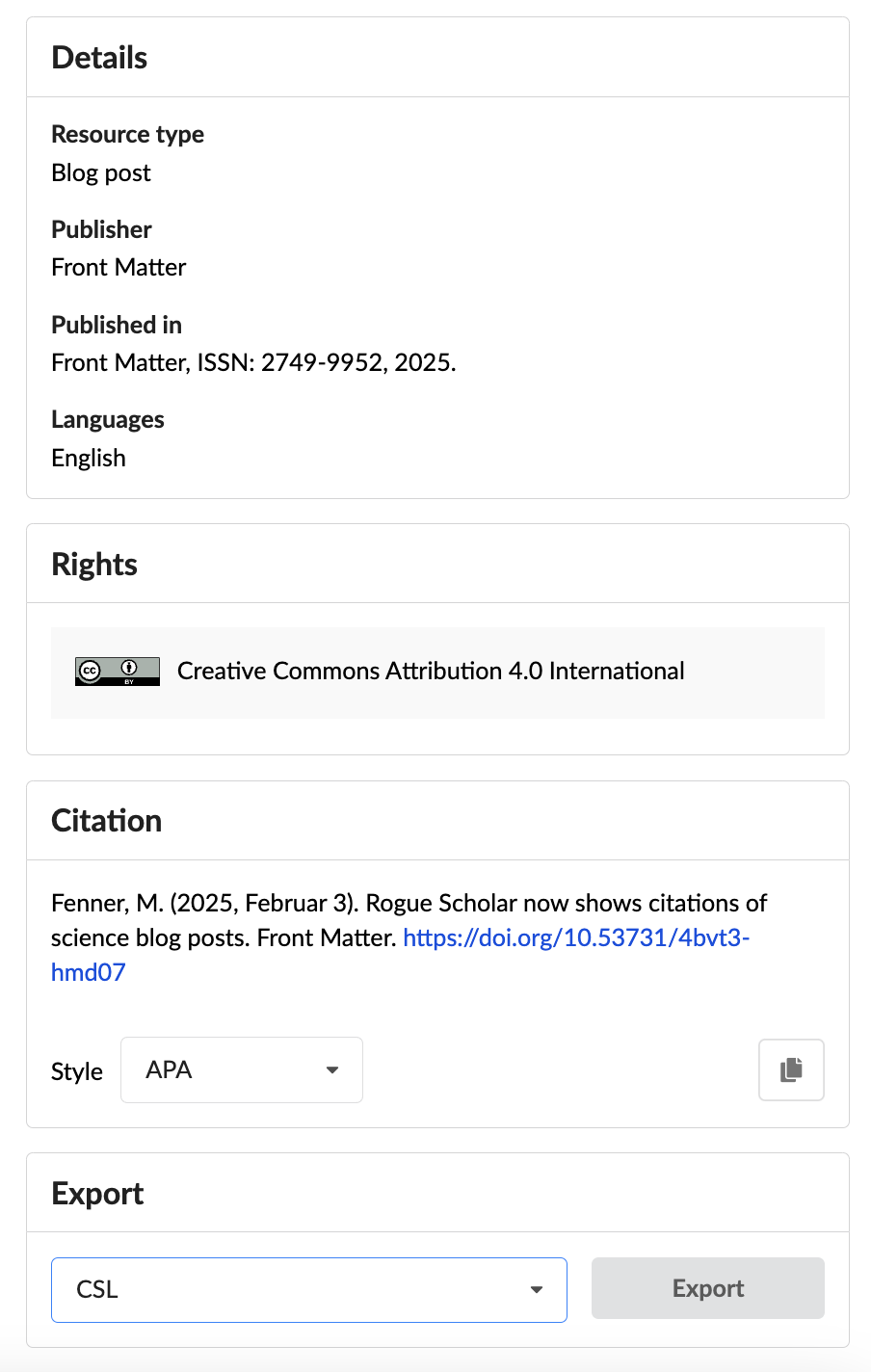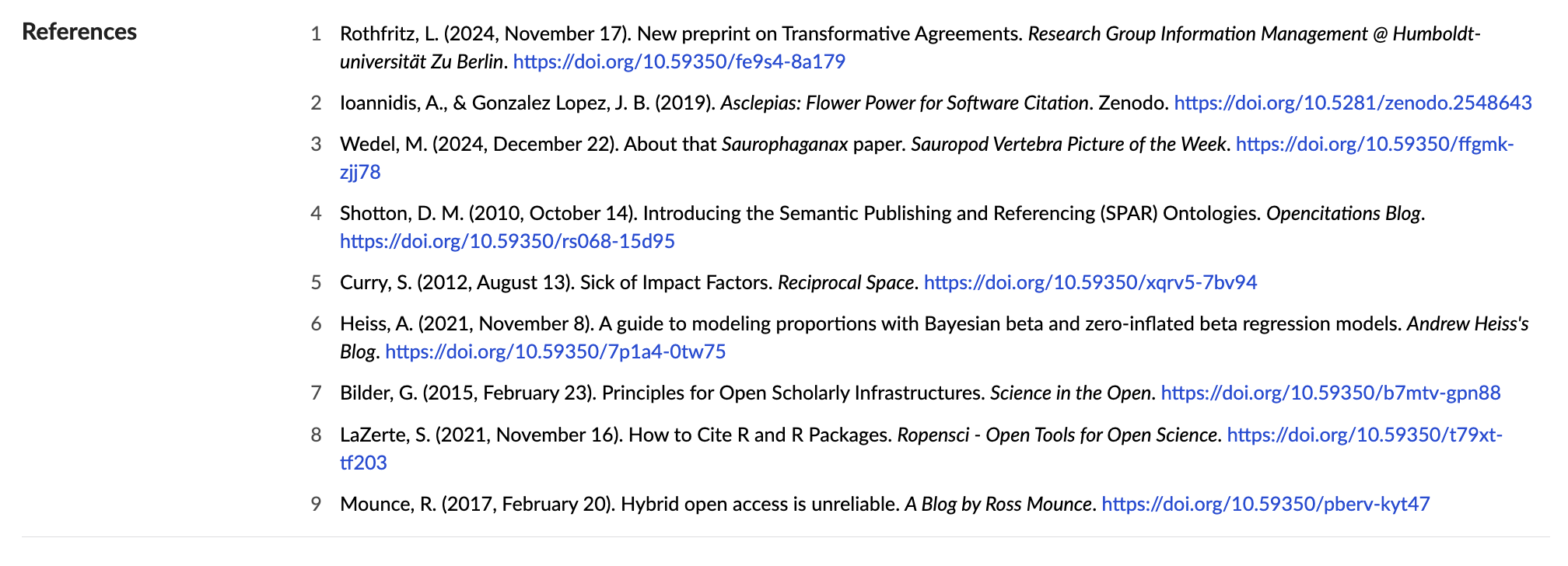In a few weeks, the Rogue Scholar science blog archive will reach the milestone of 25,000 archived science blog posts, each with a DOI and metadata and searchable via full-text search. With this number of blog posts, it is now time to start using a dedicated content type, and last week Rogue Scholar started the migration to the BlogPost content type.
There are at least two important reasons why the content type matters and Rogue Scholar now started to make the switch from Preprint to BlogPost:
- Scholarly resources are cited using citation styles, and these styles often look slightly different depending on content type, e.g. journal article, book chapter, or dataset. One popular citation style is APA and the style is used in several places in Rogue Scholar (see below).
- The content type might be helpful in understanding how science blog posts are reused, e.g. in the citations of blog posts that Rogue Scholar started displaying last week.
The blog post formatted as content type Preprint in APA style looks like this:
Fenner, M. (2025). Rogue Scholar now shows citations of science blog posts. https://doi.org/10.53731/4bvt3-hmd07
The same blog post formatted as content type BlogPost – also in APA style – looks like this:
Fenner, M. (2025, February 3). Rogue Scholar now shows citations of science blog posts. Front Matter. https://doi.org/10.53731/4bvt3-hmd07
Notice the more granular publication date and the included blog name in the latter example. On the other hand, preprint citations may include the publisher name, which is not a common concept with science blogs.
Now that Rogue Scholar distinguishes preprints from blog posts, it is easy to explore the content types of Rogue Scholar blog post citations. The 976 citations of Rogue Scholar blog posts that the Crossref Cited-by service found last week can be broken down by content type:
- Journal article 475
- Blog post 349
- Book chapter 81
- Preprint 53
- Conference proceedings 11
- Book 6
- Other 1
There is a high number of blog-to-blog citations (including self-citation of blogs), but the most common content type is journal article.
Commonmeta
The new blog post content type has to be mapped between the different metadata standards used by Rogue Scholar, mainly Crossref and DataCite for DOI registration, InvenioRDM for storing and displaying content in the Rogue Scholar repository, Citation Style Language for showing formatted citations, and BibTex and schema.org as common metadata export formats.
Rogue Scholar uses the commonmeta metadata conversion library for these conversions, and last week I updated the Python (commonmeta-py) and Go (commonmeta) versions to add support for BlogPost, also added as new type in the commonmeta JSON schema v0.15.
InvenioRDM supports custom metadata, and I added the publication-blogpost content type. DataCite allows free text in the ResourceType metadata, and I use BlogPost. Crossref has a subtype in the posted-content content type, and I hope Crossref adds blogpost at some point. Currently I use other, and use publisher Front Matter to determine that the content type is BlogPost (all DOIs by Crossref member Front Matter are for blog posts). Citation style language (post-weblog) and schema.org (BlogPosting) already support the BlogPost content type, for BibTex I continue to use article (the same type as for preprints and journal articles).
InvenioRDM
The new publication-blogpost content type shows up in list views in the Rogue Scholar repository, e.g. in search results. The content type can be translated into multiple languages, blog post is the English language version.

The resource type is also shown in the sidebar of a single record detail view, and is used to generate formatted citations, e.g. in the APA style, and to export metadata:

References and citations shown in the record details view use the APA Style and support the new BlogPost content type:

Conclusions
The switch to the new content type BlogPost might seem minor but is a strong sign that scholarly blog posts with DOIs and metadata have grown into a sizeable category of scholarly content. The distinction between BlogPost and the related Preprint will help blog posts going forward, for example with the exact publication date in references and citations, and with the ability to differentiate between these related content types in bibliometric analyses.
References
- Fenner, M. (2025, February 3). Rogue Scholar now shows citations of science blog posts. Front Matter. https://doi.org/10.53731/4bvt3-hmd07
- Fenner, M. (2025). Commonmeta-py (Version 0.78) [Computer software]. Zenodo. https://doi.org/10.5281/ZENODO.14846624
- Martin Fenner. (2025). front-matter/commonmeta: V0.6.46 (Version v0.6.46) [Computer software]. Zenodo. https://doi.org/10.5281/ZENODO.14841333


